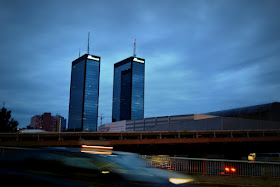Like the World Trade Center, they are two separate towers linked at ground level and sharing underground facilities. The two towers, completed in 1975, and are named Levant (eastern) and Ponant (western), with both containing 33 floors. However, although the architects, Serge Lana and Alfred H. Milh, were inspired by a construction across the Atlantic that predated theirs by only a few years, their towers topped out at 122m, only a little over quarter of the size of those of the World Trade Center!
For this reason, although obviously tall, the towers really look as if they should be higher. Indeed, with facades that reflect the sky and the fact that it is quite easy to lose sight of them from ground level, I am quite happy to include such massive structures on a blog about the invisible!
When originally planned, these towers were part of a larger project for a business district to balance that of La Defense to the west of Paris. If this scheme had gone ahead as planned, Paris would have been bookended by two ranges of high-rise buildings. A financial crisis in the mid-70s put paid to that though and Les Mercuriales remain alone in the east today.
A curiosity connected to the scheme is that one of the architects, Serge Lana, was a militant communist. Why he should have been inspired by the World Trade Center and involved in a project to build a business district is not clear, but as he spent his entire career in the eastern suburbs of Paris, he was perhaps motivated by a desire to spread wealth across the capital.
This did not happen though, and - because of these towers - Bagnolet earned the nickname of the 'La Defense des pauvres'. This is somewhat unfair, as although the surroundings remain distinctly working class, the two towers have always been a success, with occupation rates never dipping below 85%.
At ground level, the environment is not especially inspiring, but certainly very active. As an important interchange on the country's motorway system, it was the logical site to build the Paris base of the Eurolines cross-continent bus service (a place I wrote about a while back). On one side road, coaches from across Europe are parked up, resting before embarking on another epic journey. The drivers wander idly around, checking their vehicles and communicating together hesitantly in myriad languages.
The sweep of the motorway and the concrete curves of the Bagnolet interchange are visually interesting, but noisy and somewhat overpowering. Climb the steep staircase that leads from the bus station in front of the Bel'Est shopping centre though and you'll soon find yourself in another world. This is the Parc Jean-Moulin les Guilands, an area of immense greenery that sits above the east of Paris. The Les Mercuriales towers are of course still visible from here, but are shrunk down to the size of a couple of matchboxes. Hugged by trees and framed by sculptures they look a little less lonely and not unloved.







This comment has been removed by the author.
ReplyDeleteI always wondered what those two seemingly random buildings were doing there.....
ReplyDelete